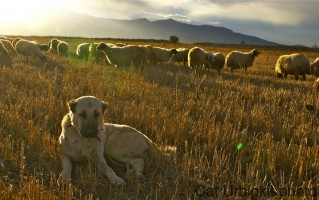
Turkish kangal with spiked collar (courtesy Cat Urbigkit)
Non-lethal tools can refer to a wide array of practices that can be grouped into a few categories. Best animal husbandry practices include such things as: 1) appropriate livestock breed selection, 2) night penning, 3) protection during birthing and of young animals, 4) carcass and bone pile removal, 5) afterbirth clean-up, 6) monitoring wolf activity and moving herds away from known wolf migratory corridors.
Active deterrents can also be implemented to keep predators away from livestock if they are known to be in the area. This class of tool includes: 1) scent repellants, 2) radio activated guard devices, 3) range riders, 4) fladry, 5) fencing, 6) livestock protection animals, and 7) hazing and harassing techniques.
These are some, but not all, of the tools that livestock owners can use to reduce the risk of predation. A few of these techniques are described in greater detail below. Please see the additional resources section to find out more information, including information about the State of Oregon’s recently enacted proactive fund for operators to utilize to reduce conflict between livestock and wolves before it happens.
Monitoring Wolf Activity
The Oregon Department of Fish and Wildlife (ODFW) offers communication resources for operators to keep track of wolf activity particularly if the wolves a GPS collar placed on them. The agency also keeps its website relatively up-to-date with pack locations and will communicate directly with operators about the specific location in relation to herds to minimize livestock depredation.
The Oregon Department of Fish and Wildlife (ODFW) offers communication resources for operators to keep track of wolf activity particularly if the wolves a GPS collar placed on them. The agency also keeps its website relatively up-to-date with pack locations and will communicate directly with operators about the specific location in relation to herds to minimize livestock depredation.
Fladry
The use of fladry as a deterrent relies on a wolf’s inherent dislike of bright colors and motion. Fladry is the use of flags tied to a rope and affixed to a pen or fence. Fladry can be used in conjunction with fencing and is relatively easy to add to an existing fence line. It can also be partnered with electric fences, sometimes referred to as turbo fladry. Fladry is often used as a temporary deterrent (up to 60 days) and can be very effective during high predation times. Some maintenance is required, as the flags need to be set in areas without obstacles. Underbrush and grass need to be trimmed depending on the height of installation.
The use of fladry as a deterrent relies on a wolf’s inherent dislike of bright colors and motion. Fladry is the use of flags tied to a rope and affixed to a pen or fence. Fladry can be used in conjunction with fencing and is relatively easy to add to an existing fence line. It can also be partnered with electric fences, sometimes referred to as turbo fladry. Fladry is often used as a temporary deterrent (up to 60 days) and can be very effective during high predation times. Some maintenance is required, as the flags need to be set in areas without obstacles. Underbrush and grass need to be trimmed depending on the height of installation.
Livestock Protection Animals
Livestock protection animals have been used worldwide for centuries. Depending on the type of predator and breed of livestock, protection animals can be donkeys, dogs, llamas and alpacas. Dogs have been widely used in the US in protecting sheep against coyotes, bears and cougars. Livestock protection dogs to deter wolves has been employed in a trial and error approach in the Rocky Mountain states. There are a number of factors that can limit effectiveness of using guard dogs against wolves, including breed, training of dogs, number of dogs, expense, geography, etc. Also, free ranging cattle pose different challenges for guard dogs as compared to sheep, which tend to flock together.
Livestock protection animals have been used worldwide for centuries. Depending on the type of predator and breed of livestock, protection animals can be donkeys, dogs, llamas and alpacas. Dogs have been widely used in the US in protecting sheep against coyotes, bears and cougars. Livestock protection dogs to deter wolves has been employed in a trial and error approach in the Rocky Mountain states. There are a number of factors that can limit effectiveness of using guard dogs against wolves, including breed, training of dogs, number of dogs, expense, geography, etc. Also, free ranging cattle pose different challenges for guard dogs as compared to sheep, which tend to flock together.
The list of breeds is long and varies by country; however, in the US common breeds are the Great Pyrenees, Akbash, Anatolian Shepherd, Komondo and Maremma. All livestock protection dogs are specifically bred for their ability to guard their herd; these animals are much different than pets. See resources below for more information about LPDs as a non-lethal tool.
Radio Activated Guard Devices
Radio Activated Guard (RAG) devices rely on a transmission emitted from a collared wolf. If a collared wolf comes into range of these devices they activate loud noises and flashing lights to scare away predators. This is an effective deterrent in smaller pasture areas due to the limited range of the RAG device. Another major drawback of these devices is the dependency on a collared wolf entering the area. If no collared wolves are part of the intruding pack, these devices are not triggered.
Radio Activated Guard (RAG) devices rely on a transmission emitted from a collared wolf. If a collared wolf comes into range of these devices they activate loud noises and flashing lights to scare away predators. This is an effective deterrent in smaller pasture areas due to the limited range of the RAG device. Another major drawback of these devices is the dependency on a collared wolf entering the area. If no collared wolves are part of the intruding pack, these devices are not triggered.
Additional Resources
1) Urbikit, C. and J. Urbigkit. 2010. A Review: The Use of Livestock Protection Dogs in Association with Large Carnivores in the Rocky Mountains. Sheep and Goat Research Journal. v. 25.
2) Stone, S. 2008. Livestock and Wolves. Defenders of Wildlife Bulletin.
3) Predator Friendly
4) Oregon Department of Fish and Wildlife and Compensation/Proactive Fund Information
5) APHIS – Protecting Livestock from Predators
6) Lava Lake Lamb
1) Urbikit, C. and J. Urbigkit. 2010. A Review: The Use of Livestock Protection Dogs in Association with Large Carnivores in the Rocky Mountains. Sheep and Goat Research Journal. v. 25.
2) Stone, S. 2008. Livestock and Wolves. Defenders of Wildlife Bulletin.
3) Predator Friendly
4) Oregon Department of Fish and Wildlife and Compensation/Proactive Fund Information
5) APHIS – Protecting Livestock from Predators
6) Lava Lake Lamb


